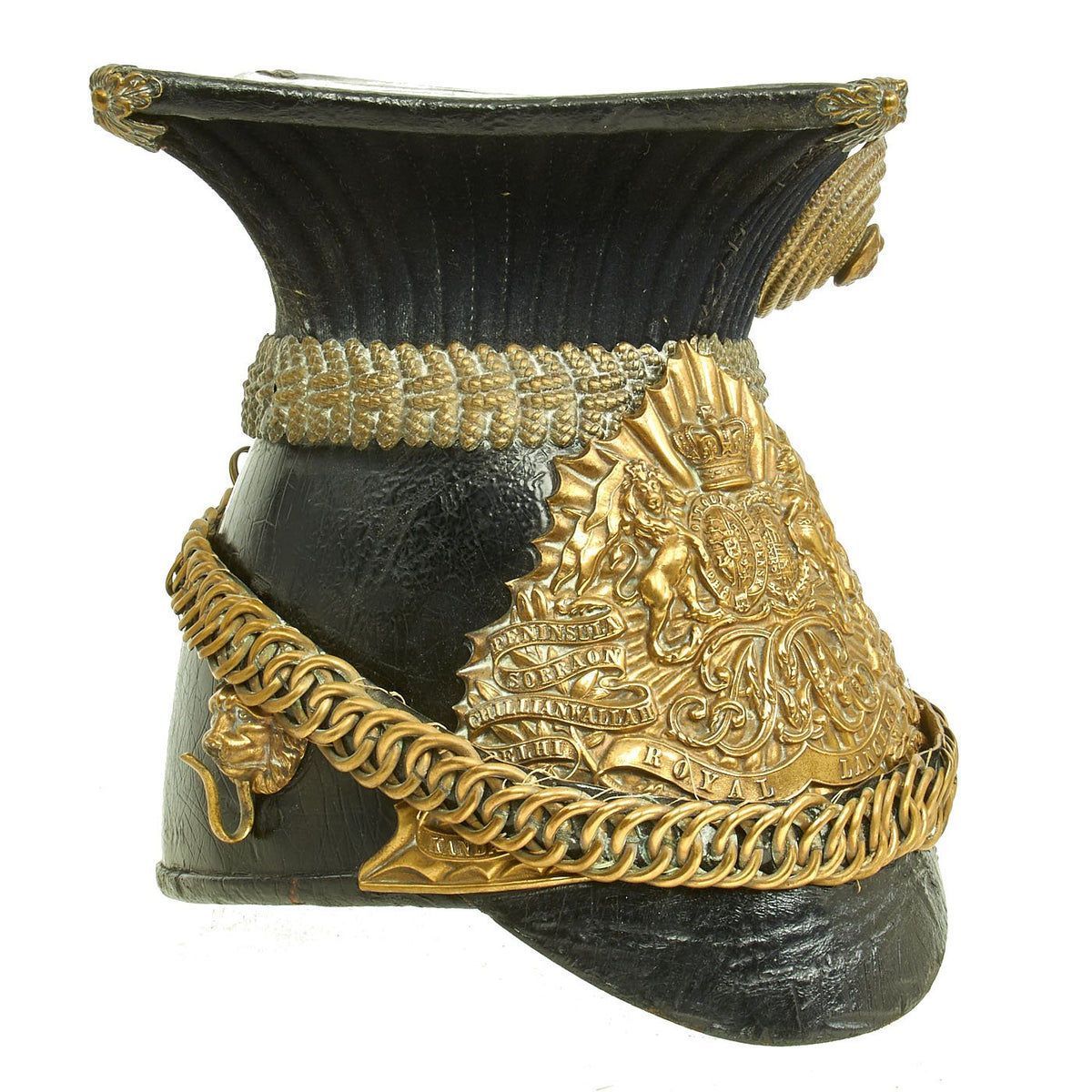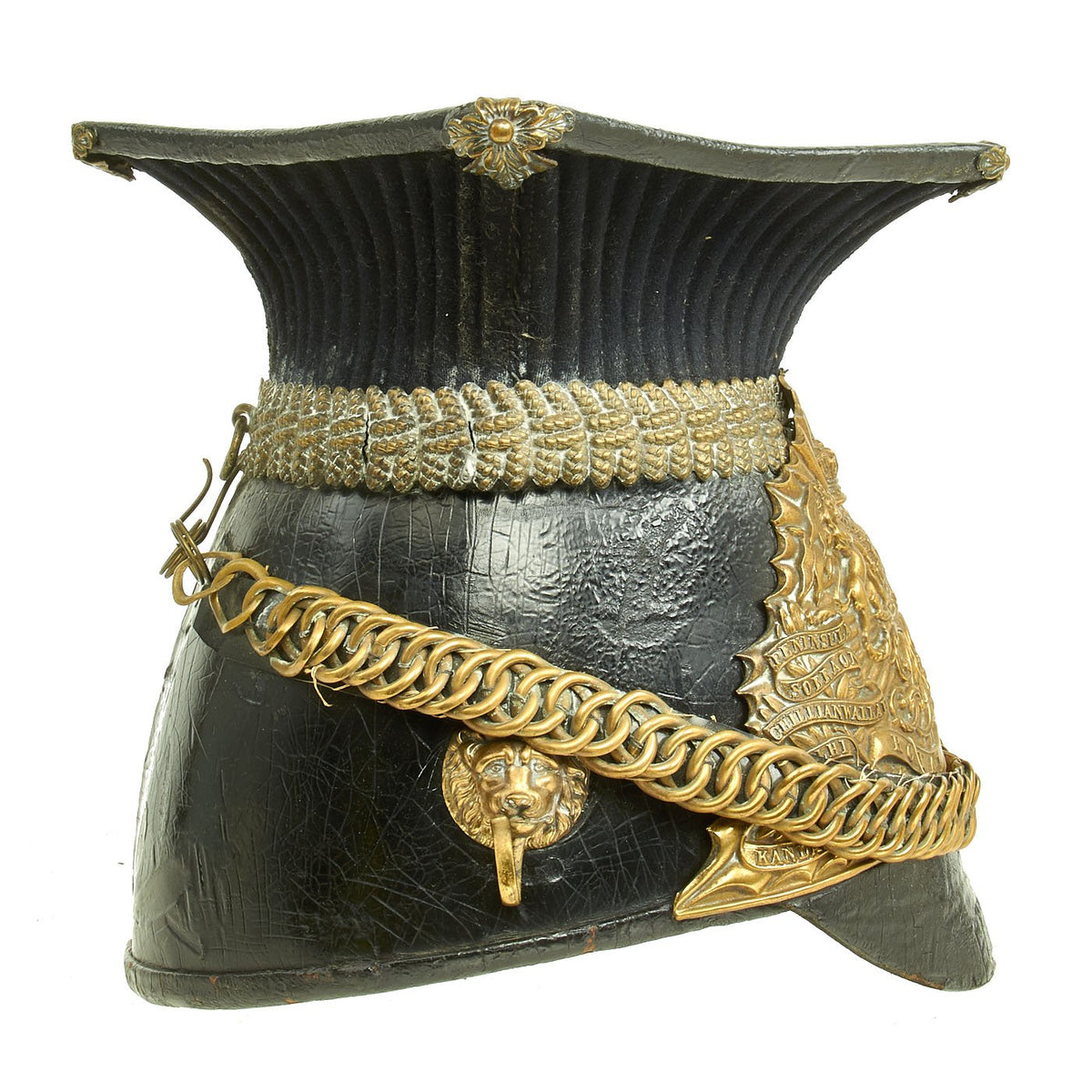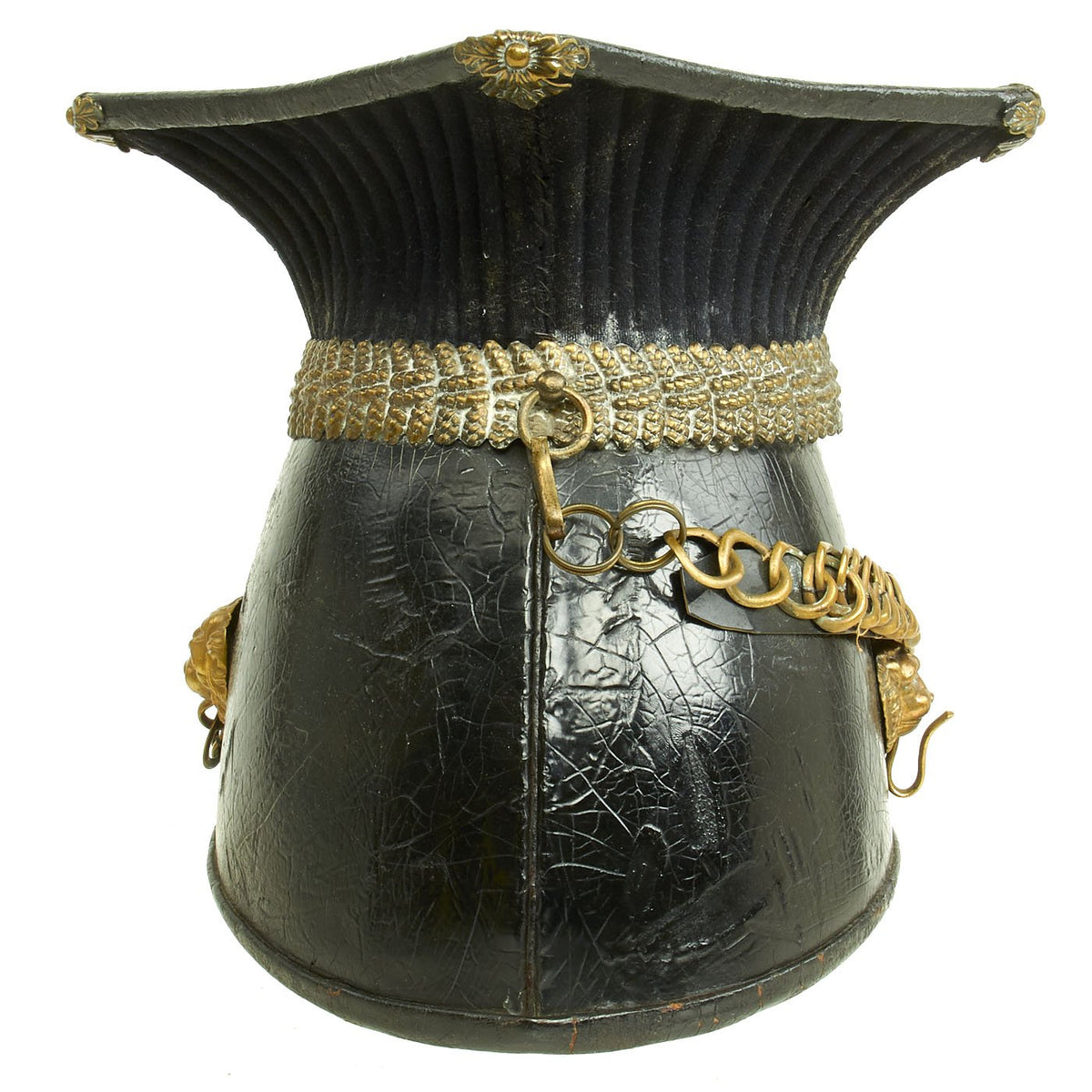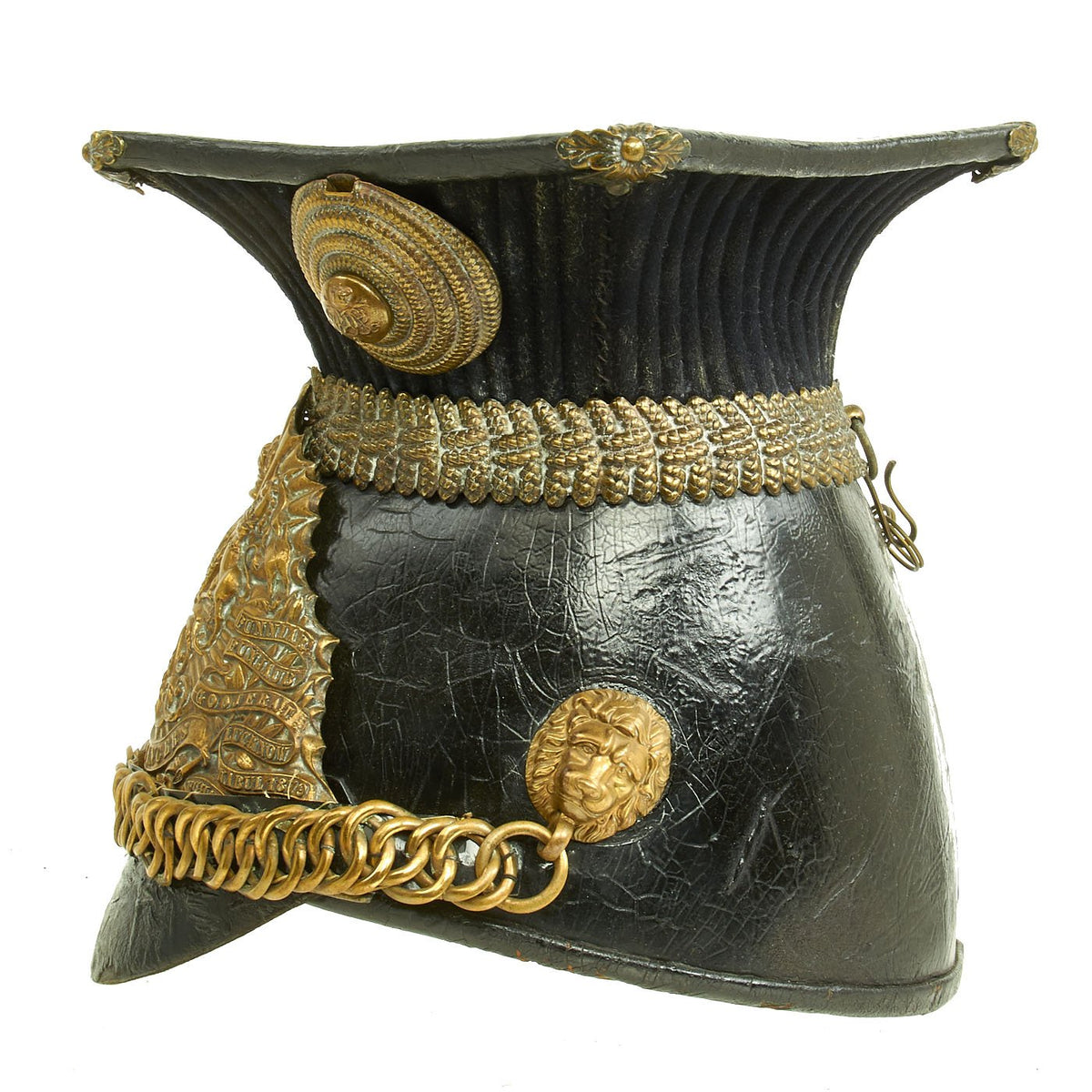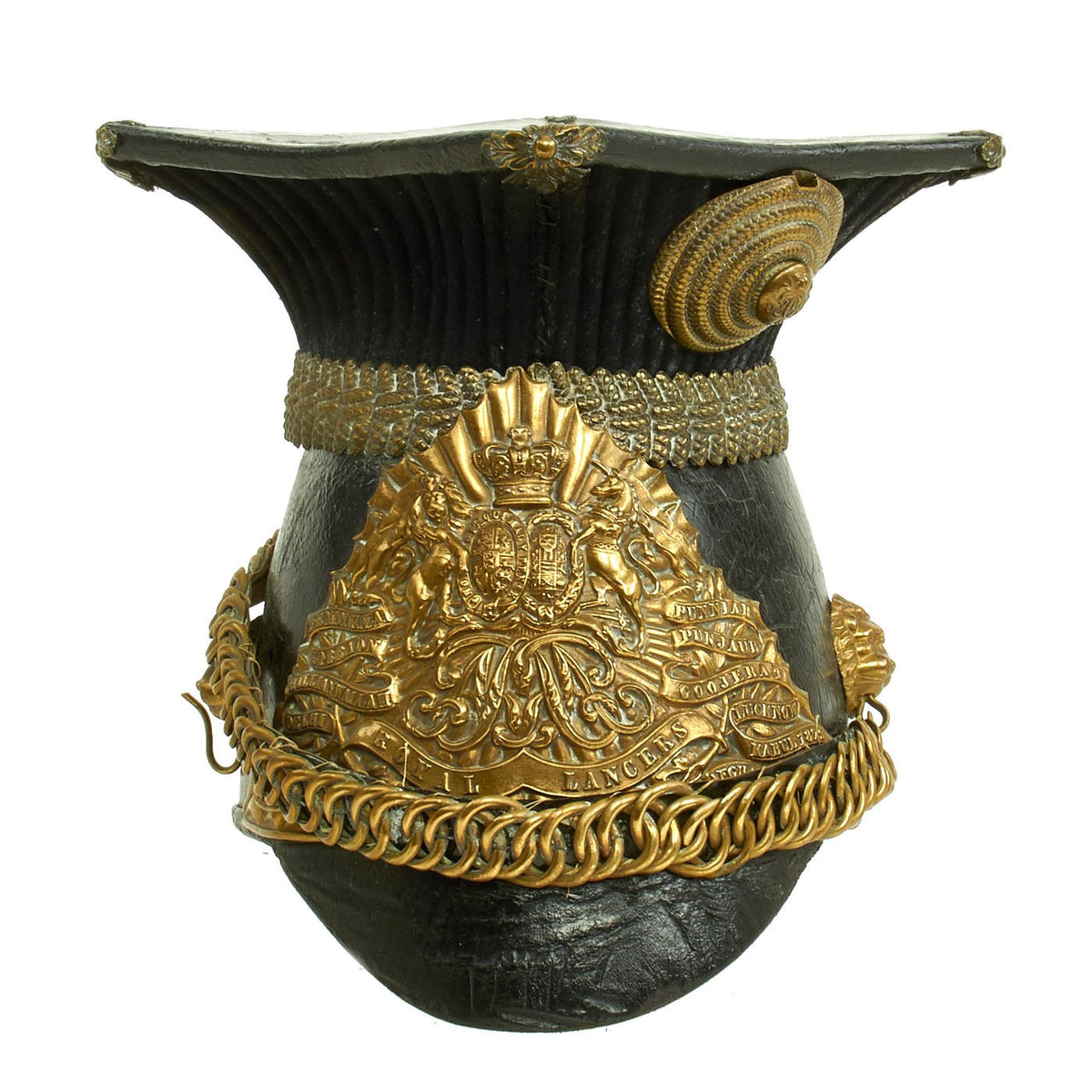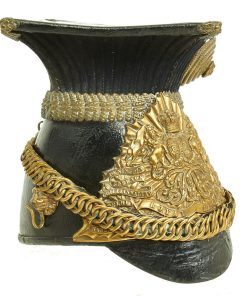Original British Victorian Era 9th Royal Lancers Other Ranks Tschapka Helmet Original Items
$ 1.995,00 $ 498,75
Original Item: Only One Available. British 19th Century Victorian 9th Royal Lancers Other Ranks Helmet Tschapka Lance Cap. The leather body has minor crazing for the period of the helmet. The Lance Cap has the correct skull and peak with correct brass rope effect waist. The rear has the correct brass ring & hook. The sides are covered in black facing cloth. Brass piping with ornate finials extends down the 4 angles. The cap has the correct brass rosette with Crown and ‘9’ (9th Lancer’s) brass button and Lion’s head bosses with correct leather backed link brass chain. Regrettably the horse hair plume is not present. The cap is fitted with correct rayed plate and badge comprising the Queens’s Crown Royal arms, Queen Adelaide ‘AR’ Royal cypher and Battle honors. The cap is complete with original leather sweat band and cotton lining. It is approximate US size 6 1/2.
The regiment was formed by Major-General Owen Wynne as Owen Wynne’s Regiment of Dragoons in Bedford in 1715 as part of the response to the Jacobite rising. The regiment’s first action was to attack the Jacobite forces in Wigan in late 1715. In 1717, the regiment embarked for Ballinrobe, in Ireland, and was placed on the Irish establishment. The regiment was ranked as the 9th Dragoons in 1719, re-titled as the 9th Regiment of Dragoons in 1751 and converted into Light Dragoons, becoming the 9th Regiment of (Light) Dragoons in 1783. The regiment fought at the Battle of Kilcullen, inflicting severe losses on the rebels, on 24 May 1798[4] and at the Battle of Carlow on 25 May 1798, when they successfully ambushed the rebels, during the Irish Rebellion. The regiment also saw action at the Battle of Vinegar Hill on 21 June 1798.
The regiment took part in Sir Samuel Auchmuty’s disastrous expedition to the River Plate in October 1806, including the occupation of Montevideo in February 1807 during the Anglo-Spanish War. It then took part in the equally unsuccessfully Walcheren Campaign in autumn 1809: a total of 152 men from the regiment died of fever during that campaign. The regiment then embarked for Portugal and fought at the Battle of Arroyo dos Molinos, capturing General De Brune of the French Army, in October 1811 during the Peninsular War. It was also part of the covering force for the Siege of Badajoz in March 1812. In April 1813, the regiment returned to England. They were re-designated as a lancer formation in 1816 and became the 9th (or Queen’s Royal) Lancers in honour of Queen Adelaide in 1830.
The regiment was posted to India in 1842. It saw action at the Battle of Punniar in December 1843 during the Gwalior Campaign. It also fought at the Battle of Sobraon in February 1846 during the First Anglo-Sikh War and undertook a successful charge at the Battle of Gujrat in February 1849 during the Second Anglo-Sikh War. The regiment then fought at the siege and capture of Delhi and the relief of Lucknow in summer 1857, as well as the capture of Lucknow in spring 1858 during the Indian Rebellion: the regiment, which was described by the rebels as “the Delhi Spearmen”, was awarded twelve Victoria Crosses. It was described by an ally as:
“The beau ideal of all that British Cavalry ought to be in Oriental countries”.[13]
The regiment was renamed the 9th (The Queen’s Royal) Lancers in 1861.
Second Anglo-Afghan War
The 9th Lancers under the command of Lieutenant Colonel Henry Bushman on the march to Kandahar in autumn 1880, painted by Orlando Norie. The troops would march in the early morning to avoid the full heat of the sun, halting a few minutes every hour. In this way, the column managed to cover up to 20 miles a day.
The regiment was posted to Afghanistan in 1878 and marched through the Khyber Pass in March 1879 as part of the cavalry brigade led by General Hugh Henry Gough. Following the murder of the British ambassador and his guards at Kabul in September 1879, the regiment saw action at the Battle of Charasiab in October 1879 during the Second Anglo-Afghan War. The commanding officer of the regiment, Lieutenant-Colonel Robert Cleland, was killed while leading a charge at the Battle of Killa Kazi in December 1879. Major-General Frederick Roberts described the ensuing events:
“The charge was led by Lieutenant-Colonel Cleland and Captain Neville, the former of whom fell dangerously wounded: but the ground, terraced for irrigation purposes and intersected by nullahs, so impeded our cavalry that the charge, heroic as it was, made little or no impression upon the overwhelming numbers of the enemy. The effort, however, was worthy and that it failed in its object was no fault of our gallant soldiers.”[15]
A squadron from the regiment took part in the Second Battle of Charasiab in April 1880 and the regiment, as a whole, undertook the long march, under the command of Lieutenant Colonel Henry Bushman, leading to the relief of Kandahar and defeat of Ayub Khan in September 1880.
Second Boer War
During the Second Boer War, the regiment took part in the Battle of Belmont and the Battle of Modder River in November 1899, as well as the Battle of Magersfontein in December 1899, Relief of Kimberley in February 1900 and the subsequent Battle of Paardeberg which resulted in Piet Cronjé’s surrender.
After the war, the regiment returned to Sialkot in the Punjab. In the Delhi Durbar of January 1903, the Duke of Connaught specially selected an escort from the 9th Lancers. This was popular with the regiment, but not with all Indian spectators; the regiment had been forbidden to take part as punishment for refusing to disclose the murderers of an Indian cook. Before he died, the man had stated that his assailants were men of the 9th Lancers. It was suggested in the press that the assailants may actually have been unsuccessful applicants for the post of cook. The Viceroy, Lord Curzon, had insisted on a collective penalty being imposed on the 9th Lancers, partially to discourage drunken assaults by British soldiers on Indian camp-followers and partially from a sense of personal outrage at efforts made by officers to conceal the facts of this particular case. The regiment was later reported to transfer from Sialkot to Rawalpindi, also in Punjab.
First World War
The charge of a squadron of the 9th Lancers against the Prussian Dragoons of the Guard at Montcel à Frétoy on 7 September 1914 (Richard Caton Woodville).
The regiment landed in France as part of the 2nd Cavalry Brigade in the 1st Cavalry Division in August 1914 for service on the Western Front.[20] Captain Francis Grenfell was awarded the Victoria Cross for his actions in saving the guns of 119th Battery, Royal Field Artillery on 24 August 1914 (he was later killed in action on 24 May 1915, as was his twin brother, Riversdale, a yeomanry officer who attached to 9th Lancers). The regiment then participated in the final “lance on lance” action involving British cavalry of the First World War; on 7 September 1914 at Montcel à Frétoy in which Lieutenant Colonel David Campbell led a charge of two troops of B Squadron and overthrew a squadron of the Prussian Dragoons of the Guard.
Inter-war
The regiment was renamed the 9th Queen’s Royal Lancers in 1921. It was deployed to Ireland and lost nine of its men in the Scramogue ambush of March 1921 during the Irish War of Independence. In addition to the lack of conflicts, their relative inactivity was also due to the military high command struggling to decide what role cavalry regiments could perform in modern warfare. Lances ceased to be carried by the six lancer regiments in the British Army for active service in 1928, though the impressive if archaic weapon was retained for ceremonial parades and guard duties. In the case of the 9th Lancers, lances were formally withdrawn in 1932, four years before they lost their horses. In the spring of 1938, the 1st Mobile Division, later to become the 1st Armoured Division, was formed: the 2nd Armoured Brigade, which included the 9th Lancers, was assigned to it.
Fast Shipping with Professional Packaging
Thanks to our longstanding association with UPS FedEx DHL, and other major international carriers, we are able to provide a range of shipping options. Our warehouse staff is expertly trained and will wrap your products according to our exact and precise specifications. Prior to shipping, your goods will be thoroughly examined and securely secured. We ship to thousands clients each day across multiple countries. This shows how we're dedicated to be the largest retailer on the internet. Warehouses and distribution centres can be located throughout Europe as well as the USA.
Note: Orders with more than one item will be assigned a processing date depending on the item.
Before shipping before shipping, we'll conduct a thorough inspection of the items you have ordered. Today, the majority of orders will be delivered within 48 hours. The delivery time will be between 3-7 days.
Returns
The stock is dynamic and we cannot completely manage it because multiple stakeholders are involved, including our factory and warehouse. So the actual stock may alter at any time. It's possible that you may not receive your order once the order has been made.
Our policy is valid for a period of 30 days. If you don't receive the product within 30 days, we are not able to issue a refund or an exchange.
You can only return an item if it is unused and in the same state as the day you received it. You must have the item in its original packaging.
Related products
Uncategorized
Uncategorized
Uncategorized
Uncategorized
Uncategorized
Uncategorized
Uncategorized
Uncategorized
Armoured Fighting Vehicles of the World: AFVs of World War One (Hardcover Book) New Made Items
Uncategorized
Australian WWII Owen MK1 Machine Carbine SMG Custom Fabricated Replica with Sling Original Items
Uncategorized
Uncategorized
Uncategorized
Uncategorized
Uncategorized
Uncategorized
Uncategorized
Uncategorized
